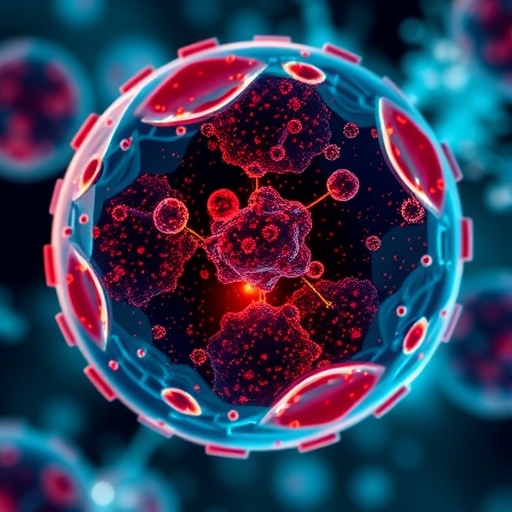In a groundbreaking advancement poised to revolutionize cancer immunotherapy, researchers at the Changchun Institute of Applied Chemistry, Chinese Academy of Sciences, have engineered an innovative class of biodegradable cesium nanosalts that activate anti-tumor immunity through orchestrated cellular pyroptosis and metabolic interference. This pioneering work, appearing in the esteemed journal CCS Chemistry, introduces a sophisticated strategy leveraging nanosalt-induced ion homeostasis disruption to combat malignant tumors with unprecedented precision.
The therapeutic mechanism of these cesium-based nanosalts hinges on a cleverly designed “Trojan horse” approach. Unlike conventional methods that rely on ion channels, these nanosalts exploit endocytosis to infiltrate tumor cells stealthily. Upon cellular entry, the nanosalts dissolve, releasing cesium ions (Cs⁺) that disrupt the delicate ionic equilibrium within the cytoplasm. This ionic disequilibrium generates a surge in osmotic pressure, compelling the cell to swell and ultimately triggering pyroptosis—a highly inflammatory form of programmed cell death. This death pathway not only eliminates malignant cells but also ignites a potent immune response against the tumor microenvironment.
Cesium’s unique capacity to inhibit sodium/glucose cotransporter activity adds a compelling metabolic dimension to this therapeutic platform. By suppressing the function of these transporters, Cs⁺ derails glucose uptake, effectively starving tumor cells of their primary energy source. This metabolic sabotage impairs the tumor’s proliferative capabilities and synergizes with pyroptotic signaling to heighten cellular demise.
Enhancement of therapeutic efficacy is achieved through the co-delivery of docosahexaenoic acid (DHA), a dietary nutrient known for its bioactive properties. DHA not only amplifies pyroptosis but also induces immunogenic ferroptosis, a distinct form of regulated cell death characterized by iron-dependent lipid peroxidation. The dual activation of pyroptosis and ferroptosis by cesium nanosalts loaded with DHA culminates in a multifaceted immune activation cascade, marked by the robust release of damage-associated molecular patterns (DAMPs) and pro-inflammatory cytokines.
These DAMPs, liberated upon pyroptotic and ferroptotic cell death, serve as critical danger signals that reprogram the immunosuppressive tumor microenvironment. By engaging phagocytosis-related receptors on antigen-presenting cells, they facilitate enhanced antigen presentation and recruit a diverse array of immune effector cells. The resultant immune milieu favors the proliferation and activation of T cells, culminating in a systemic and durable anti-tumor immune response capable of curtailing tumor growth and metastasis.
The synthesis of the cesium nanosalts represents a seminal advance in nanoparticle engineering. Researchers developed a novel method enabling precise size control across a wide range, tailoring the nanomaterial for optimal cellular uptake and ion release kinetics. This method’s fine control over physicochemical parameters ensures that the nanosalts are fully biodegradable and safe, addressing a key limitation in the development of ion-interference therapies.
In vitro and in vivo investigations have systematically validated the therapeutic potential of these nanosalts. Cell culture models demonstrated effective induction of pyroptosis and metabolic disruption, while animal studies revealed significant inhibition of tumor invasion and metastatic spread. These results affirm the ability of the nanosalts to reshape the tumor immune environment and impede cancer progression through multiple, complementary mechanisms.
This platform overcomes longstanding challenges in nanosalt development, expanding the library of available nanomaterials with demonstrated ion-interference therapeutic functionalities. The exploitation of cesium ions marks a novel trajectory distinct from the commonly explored metal ions, underscoring the versatility of nanosalts for tumor immunotherapy. Furthermore, the liposome encapsulation technology employed ensures the simultaneous delivery of the pyroptosis inducer DHA and regulation of ion dissolution, optimizing therapeutic payload release.
The strategic integration of ion channel bypass, metabolic interference, and dual cell-death pathway induction heralds a new paradigm in cancer nanomedicine. By effectively coupling physical disruption with immune activation, this approach redefines how malignant tumors can be targeted. The elucidation of these complex biological mechanisms deepens our understanding of tumor-immune interactions and opens avenues for the design of next-generation immunotherapeutic agents.
Looking forward, this biodegradable cesium nanosalt system has vast potential for clinical translation. Its design aligns with the growing emphasis on multifunctional nanoplatforms that combine direct tumor cytotoxicity with immune system engagement. As immunotherapy continues to transform oncology, such innovations provide vital tools to overcome resistance mechanisms and improve patient outcomes.
Moreover, the introduction of ferroptosis as a co-activated cell death mode enriches immune activation strategies. The immunogenic nature of ferroptosis complements pyroptosis by further enhancing antigen release and immune cell recruitment. This synergy between disparate regulated cell death pathways exemplifies cutting-edge therapeutic design principles centered on harnessing endogenous death signals to potentiate anti-tumor immunity.
In summary, the creation of biodegradable cesium nanosalts with multifunctional anti-tumor capabilities exemplifies a quantum leap in nanotherapeutic strategies. By merging ion interference, metabolic disruption, pyroptosis, and ferroptosis induction, this technology exemplifies how nanoscience can unlock complex biological responses for effective cancer treatment. The collaborative effort by Academician Hongjie Zhang and colleagues signifies a major stride in constructing highly efficacious, versatile immunostimulatory nanosystems, promising a new frontier in oncology therapeutics.
Subject of Research:
Not applicable
Article Title:
Biodegradable Cesium Nanosalts Activating Antitumor Immunity via Inducing Cellular Pyroptosis and Interfering with Metabolism
News Publication Date:
3-Nov-2025
Web References:
https://www.chinesechemsoc.org/journal/ccschem
References:
10.31635/ccschem.025.202506187
Image Credits:
CCS Chemistry
Keywords
Biodegradability
Tags: anti-tumor immunity mechanismsbiodegradable cesium nanosaltscancer immunotherapy innovationsCCS Chemistry journal researchcellular endocytosis in cancer therapyengineered nanomaterials for oncologyion homeostasis disruptionmetabolic interference in cancer treatmentosmotic pressure and cell deathpyroptosis in tumor cellssodium/glucose cotransporter inhibitionTrojan horse drug delivery





